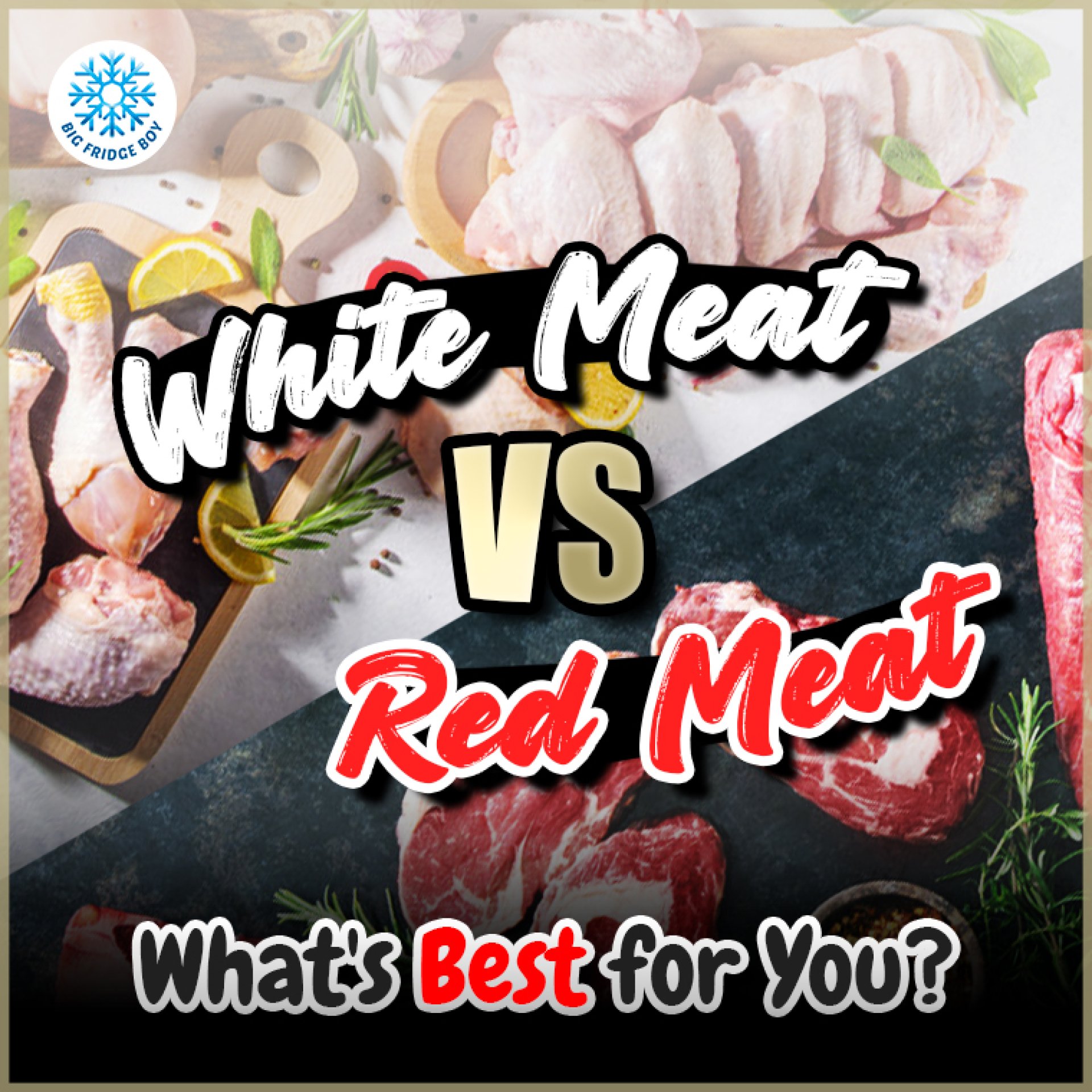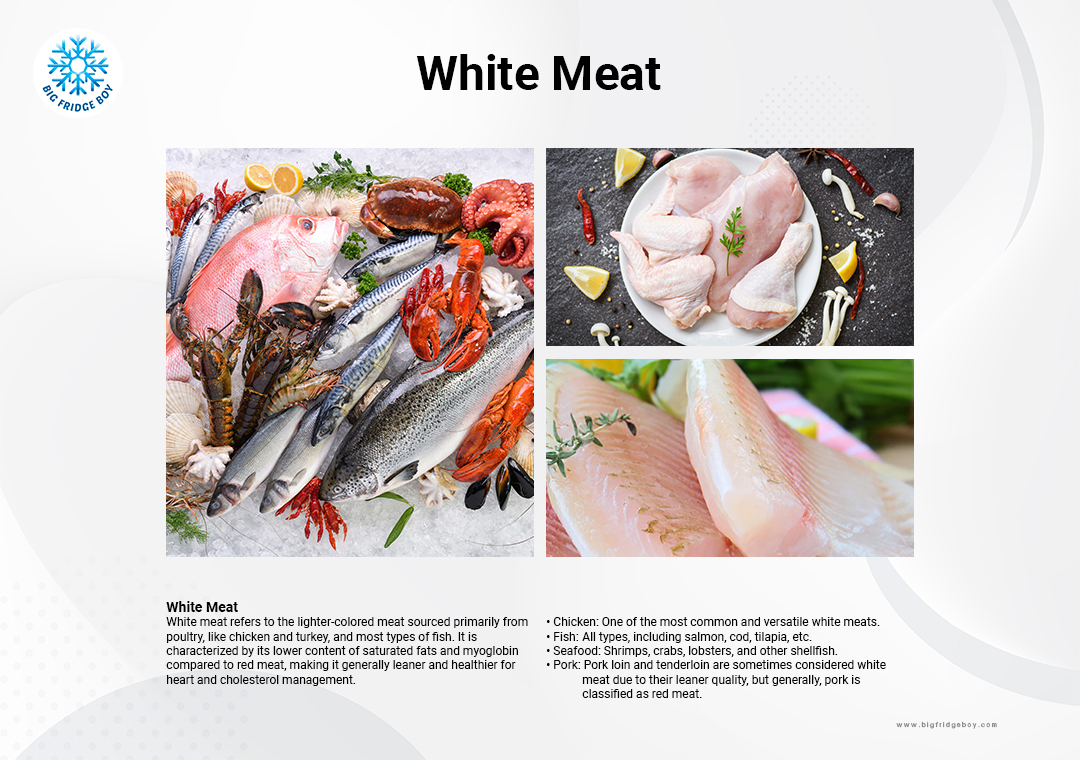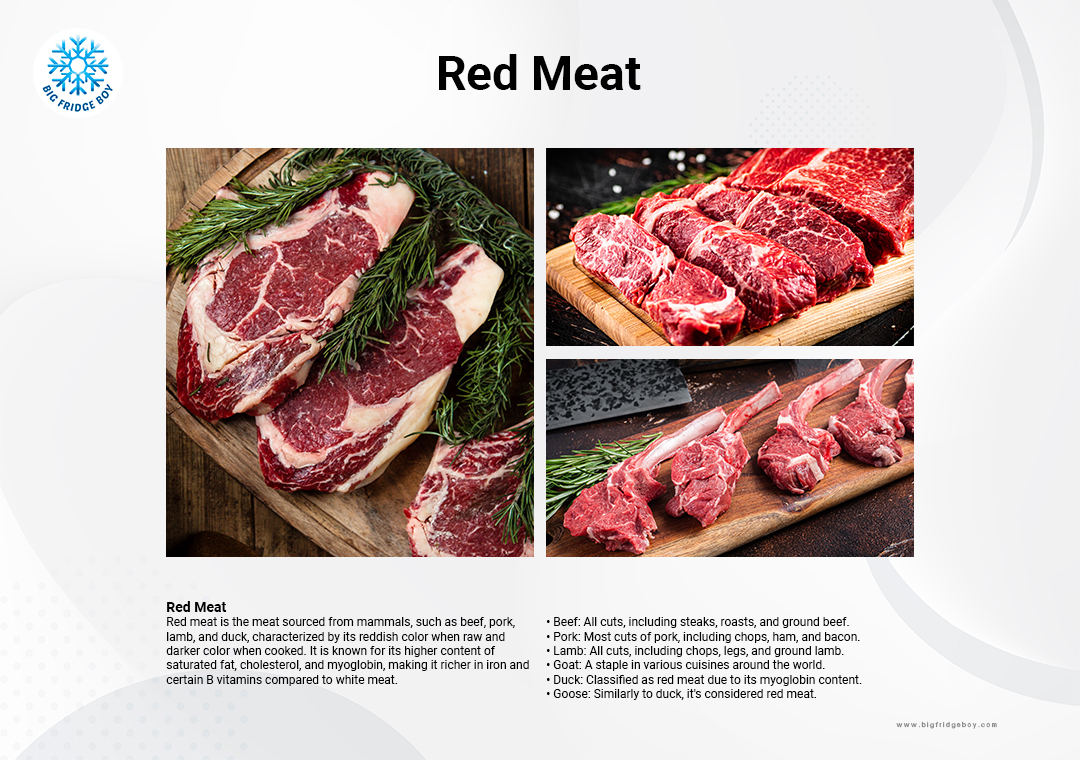"White Meat vs Red Meat: Choosing What's Best for You"

Deciding whether white meat or red meat is "better" depends on individual health goals, dietary preferences, and specific nutritional needs. Both types of meat have their unique advantages and can be part of a healthy diet. Here's a comparison to help you decide based on your personal needs:
This detailed exploration delves into the sources, classify, nutritional content, and advantages surrounding white and red meats, offering a comprehensive view for those aiming to balance taste and health in their diets.
Sources

White Meat
- Chicken: One of the most common and versatile white meats.
- Fish: All types, including salmon, cod, tilapia, etc.
- Seafood: Shrimps, crabs, lobsters, and other shellfish.
- Pork: Pork loin and tenderloin are sometimes considered white meat due to their leaner quality, but generally, pork is classified as red meat.

Red Meat
- Beef: All cuts, including steaks, roasts, and ground beef.
- Pork: Most cuts of pork, including chops, ham, and bacon.
- Lamb: All cuts, including chops, legs, and ground lamb.
- Goat: A staple in various cuisines around the world.
- Duck: Classified as red meat due to its myoglobin content.
- Goose: Similarly to duck, it's considered red meat.
Classify
Classifying meat as white or red primarily depends on the type of animal it comes from and the myoglobin content in the muscle. Myoglobin is a protein found in muscle cells that binds to oxygen and iron, giving the muscle its color. Here's a more detailed explanation:
Animal Source
- White Meat: Typically comes from poultry like chicken and as well as most types of fish. These animals have muscle fibers that are adapted for short bursts of activity and have less myoglobin.
- Red Meat: Generally comes from mammals such as beef (cows), pork (pigs), lamb, and venison (deer). The muscles of these animals are used more for endurance, leading to higher myoglobin content and a darker color.
Myoglobin Content
- High Myoglobin: Red meats have a higher concentration of myoglobin in the muscle fibers, which gives the meat a darker, red color. This is especially true for muscles that are used more frequently and require more oxygen.
- Low Myoglobin: White meat has lower myoglobin levels, resulting in a lighter color. This is typical for muscles that aren't used as intensively.
Cooking and Texture
- Texture Changes: When cooked, red meat typically remains dark or turns brown, while white meat usually becomes lighter or stays pale.
- Texture and Fat Content: Red meats are often more marbled with fat, contributing to a different texture and flavor profile compared to leaner white meats.
Exceptions
- Pork: Sometimes marketed as "the other white meat," pork is scientifically classified as red meat due to its higher myoglobin content compared to poultry and fish. However, some cuts of pork are leaner, leading to this confusion.
- Duck and Goose: Although they are poultry, duck and goose are classified as red meat because their muscles are used in sustained flying, resulting in higher myoglobin content.
Advantages of White Meat
- Lower in Saturated Fat and Cholesterol: White meat, particularly poultry and fish, typically contains less saturated fat and cholesterol compared to red meat. This makes it a healthier choice for heart health and cholesterol management.
- High-Quality Protein: White meat is an excellent source of lean protein, essential for muscle growth and repair, without the additional saturated fat often found in red meat.
- Rich in Certain Nutrients: Fish, a type of white meat, is high in omega-3 fatty acids, which are beneficial for heart health, brain function, and inflammation reduction.
- Lower Calorie Content: Generally, white meat has fewer calories than red meat, making it a preferable option for weight management and dieting.
- Reduced Health Risks: Consuming white meat is associated with a lower risk of developing certain diseases linked to red meat consumption, such as colorectal cancer and heart disease.
- Versatile in Cooking: White meat can be used in a variety of dishes and is often quicker to cook than red meat, making it a convenient option for meals.
Advantages of Red Meat
- Rich Source of Iron: Red meat is a significant source of heme iron, which is more easily absorbed by the body compared to non-heme iron found in plant foods. This is especially important for individuals prone to iron-deficiency anemia.
- High in B Vitamins: Red meat contains high levels of B vitamins, particularly vitamin B12, which is essential for nerve function and the formation of DNA and red blood cells. Vitamin B12 is not found naturally in plant foods.
- Contains Zinc and Selenium: It is a good source of zinc, important for immune function, and selenium, which plays a critical role in metabolism and thyroid function.
- Provides Complete Protein: Red meat offers complete protein with all essential amino acids necessary for bodily functions.
- Contributes to Muscle Growth and Maintenance: The high-quality protein and essential amino acids in red meat are beneficial for muscle growth, repair, and maintenance, especially important for athletes and older adults.
- Satiety and Flavor: Red meat is often more satisfying and flavorful, making it a popular choice for many diets and culinary preferences.
The distinction between white and red meats is more than just a culinary preference; it's a decision that impacts our health, cooking methods, and even our environmental footprint. While white meats like chicken, fish, and turkey offer the advantages of being low in saturated fat and high in certain nutrients such as omega-3 fatty acids, red meats stand out for their rich content of iron, B vitamins, and their ability to provide complete proteins.
Ultimately, there isn't a definitive answer to which is "better" as it varies by individual circumstances. Moderation and variety are key in any diet.





